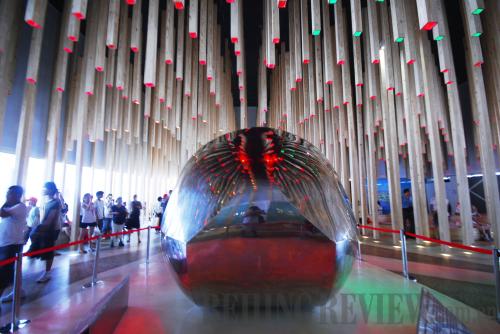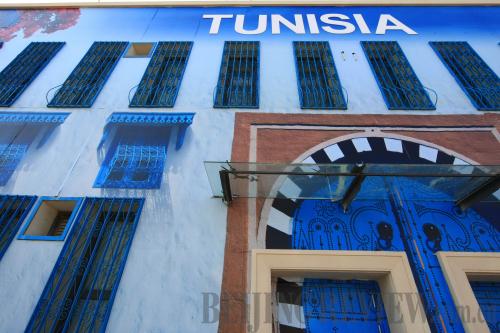|
 |
|
BALANCED: A huge stainless-steel Gomboc on display at the Hungary Pavilion on July 22 (CFP) |
It is quite a physical challenge to tour all the exhibits of the more than 200 participant countries, regions, international organizations and businesses at the ongoing World Expo in Shanghai. So, many visitors choose to see the bigger and famous pavilions first. But while larger pavilions feature more science and technology, smaller pavilions are the places to see pristine scenery, unique housing, exotic customs and fun activities.
Into Africa
Because of its distance to China and its diversified and unique cultures, Africa is a mysterious land for many Chinese. The Africa Joint Pavilion houses exhibits from more than 40 African countries and offers a rare opportunity for visitors to catch a glimpse of the continent.
 |
|
TUNISIA AT EXPO: The facade of the Tunisia Pavilion takes on the blue color of the Mediterranean Sea (YU XIANGJUN) | The exterior wall of the Africa Joint Pavilion depicts a typical sunset on the African prairie. Silhouetted against the colorful clouds are a tree with a huge canopy, elephants, giraffes, zebras and other animals.
A wall of 29 faces, including that of Lucy, a female hominid—the ancestor of modern human beings, greets visitors at the entrance to the pavilion. Africa is thought to be the birthplace of mankind. Lucy's remains were discovered in Ethiopia in 1974. She is estimated to have lived there 3.2 million years ago.
Many pavilions take unique shapes that reflect their natural environment and culture. The Benin Pavilion looks like a chateau, with creamy coffee-colored walls and light gray cone-shaped roofs. The pavilion draws inspiration from a royal palace and traditional residential buildings in the country. Inside the pavilion are exhibitions on urban and rural life in the country, its traditional culture and valuable handicrafts such as bronze work, woodcarvings, copper sculptures and ivory carvings.
A Yardang landform is featured at the entrance of Chad Pavilion. Yardang is a rock ridge formed by persisting wind and water erosion and often looks bizarre and spectacular. In the Sahara Desert in northeast Chad, there are many natural arches typical of Yardang landforms. On the pavilion's walls, films show the country's fascinating landscapes and folk culture.
The elegant mushroom-shaped house of the Cote d'lvoire Pavilion looks like a scene from wonderland. Adopting the three colors of the country's national flag—orange, white and green, the house looks pleasant and stylish.
An imposing elephant-shaped rock welcomes visitors to the Namibia Pavilion. Beside the rock is a tall baobab tree. In the pavilion, by following signposts of distinct traditional styles, visitors can travel through the beautiful Fish River Canyon and 11 key cities and regions of Namibia. The pavilion has provided visitors with a small Namibian shed, where they can take a rest and enjoy delicious local cuisine. In order to create a genuine Namibia atmosphere, the pavilion's staff members are all Namibians.
At the Seychelles Pavilion visitors are greeted by the beautiful Coco de Mer palm forest, shimmering blue waves of the sea and the grotesque-shaped stones. The pavilion seeks to give visitors a view of Seychelles's natural scenery.
In the Comoros Pavilion, visitors can see a specimen of coelacanth, the oldest breed of fish in the world. Coelacanth was thought to have been extinct 80 million years ago until a living one was discovered in Comoros in 1938. The fish is now one of the country's national treasures.
Idi Nadhoim, the country's Vice President, told Chinese media in July that "in Comoros, the coelacanth is a symbol of longevity, while we know in China fish are regarded as auspicious creatures, thus we display the fish here to express our best wishes to Chinese people."
| 